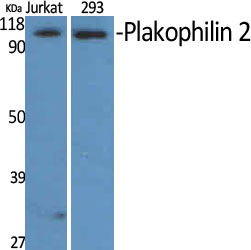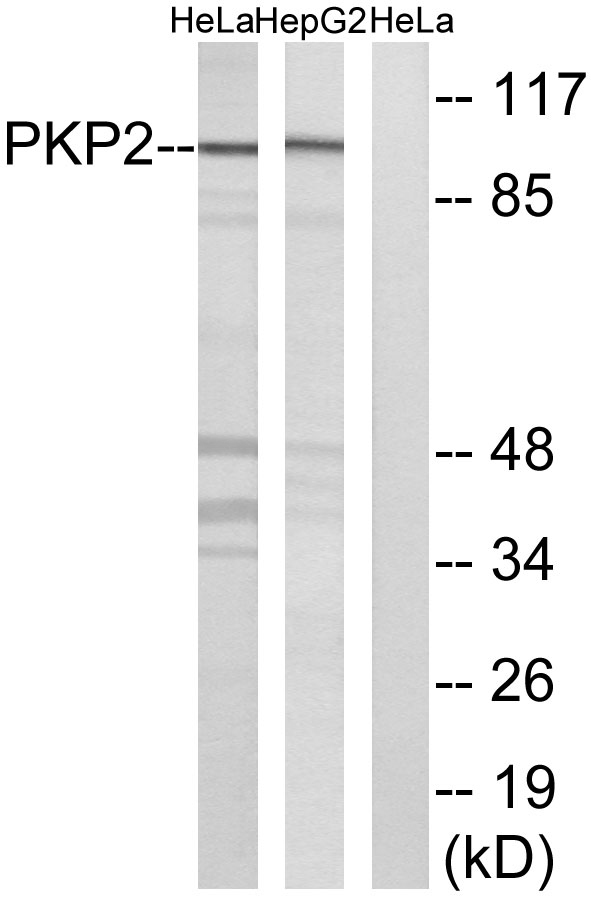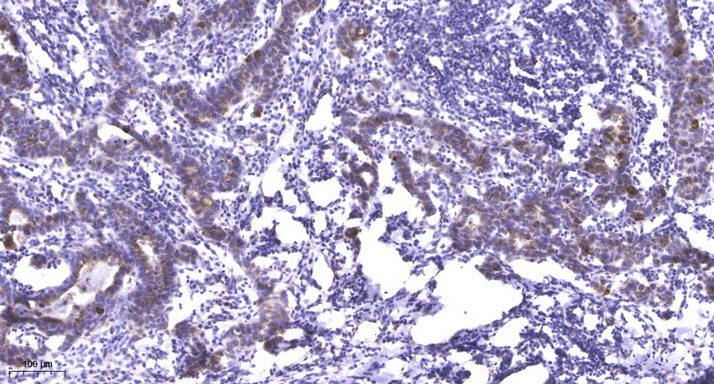Plakophilin 2 Polyclonal Antibody
- Catalog No.:YT3784
- Applications:WB;ELISA;IHC
- Reactivity:Human;Rat
- Target:
- Plakophilin 2
- Fields:
- >>Arrhythmogenic right ventricular cardiomyopathy
- Gene Name:
- PKP2
- Protein Name:
- Plakophilin-2
- Human Gene Id:
- 5318
- Human Swiss Prot No:
- Q99959
- Immunogen:
- The antiserum was produced against synthesized peptide derived from human PKP2. AA range:632-681
- Specificity:
- Plakophilin 2 Polyclonal Antibody detects endogenous levels of Plakophilin 2 protein.
- Formulation:
- Liquid in PBS containing 50% glycerol, 0.5% BSA and 0.02% sodium azide.
- Source:
- Polyclonal, Rabbit,IgG
- Dilution:
- WB 1:500-2000;IHC 1:50-300; ELISA 2000-20000
- Purification:
- The antibody was affinity-purified from rabbit antiserum by affinity-chromatography using epitope-specific immunogen.
- Concentration:
- 1 mg/ml
- Storage Stability:
- -15°C to -25°C/1 year(Do not lower than -25°C)
- Other Name:
- PKP2;Plakophilin-2
- Observed Band(KD):
- 97kD
- Background:
- This gene encodes a member of the arm-repeat (armadillo) and plakophilin gene families. Plakophilin proteins contain numerous armadillo repeats, localize to cell desmosomes and nuclei, and participate in linking cadherins to intermediate filaments in the cytoskeleton. This gene product may regulate the signaling activity of beta-catenin. Two alternately spliced transcripts encoding two protein isoforms have been identified. A processed pseudogene with high similarity to this locus has been mapped to chromosome 12p13. [provided by RefSeq, Jul 2008],
- Function:
- disease:Defects in PKP2 are the cause of familial arrhythmogenic right ventricular dysplasia 9 (ARVD9) [MIM:609040]; also known as arrhythmogenic right ventricular cardiomyopathy 9 (ARVC9). ARVD is an autosomal dominant disease characterized by partial degeneration of the myocardium of the right ventricle, electrical instability, and sudden death. It is clinically defined by electrocardiographic and angiographic criteria; pathologic findings, replacement of ventricular myocardium with fatty and fibrous elements, preferentially involve the right ventricular free wall.,function:May play a role in junctional plaques.,PTM:Phosphorylated upon DNA damage, probably by ATM or ATR.,similarity:Belongs to the beta-catenin family.,similarity:Contains 8 ARM repeats.,subcellular location:Nuclear and associated with desmosomes.,tissue specificity:Widely expressed. Found at desmosomal plaques in simple
- Subcellular Location:
- Nucleus . Cell junction, desmosome . Nuclear and associated with desmosomes.
- Expression:
- Detected in heart right ventricle (at protein level). Widely expressed. Found at desmosomal plaques in simple and stratified epithelia and in non-epithelial tissues such as myocardium and lymph node follicles. In most stratified epithelia found in the desmosomes of the basal cell layer and seems to be absent from suprabasal strata.
- June 19-2018
- WESTERN IMMUNOBLOTTING PROTOCOL
- June 19-2018
- IMMUNOHISTOCHEMISTRY-PARAFFIN PROTOCOL
- June 19-2018
- IMMUNOFLUORESCENCE PROTOCOL
- September 08-2020
- FLOW-CYTOMEYRT-PROTOCOL
- May 20-2022
- Cell-Based ELISA│解您多样本WB检测之困扰
- July 13-2018
- CELL-BASED-ELISA-PROTOCOL-FOR-ACETYL-PROTEIN
- July 13-2018
- CELL-BASED-ELISA-PROTOCOL-FOR-PHOSPHO-PROTEIN
- July 13-2018
- Antibody-FAQs
- Products Images

- Western Blot analysis of various cells using Plakophilin 2 Polyclonal Antibody diluted at 1:500 cells nucleus extracted by Minute TM Cytoplasmic and Nuclear Fractionation kit (SC-003,Inventbiotech,MN,USA).
.jpg)
- Western Blot analysis of HepG2 cells using Plakophilin 2 Polyclonal Antibody diluted at 1:500 cells nucleus extracted by Minute TM Cytoplasmic and Nuclear Fractionation kit (SC-003,Inventbiotech,MN,USA).

- Western blot analysis of lysates from HeLa and HepG2 cells, using PKP2 Antibody. The lane on the right is blocked with the synthesized peptide.

- Immunohistochemical analysis of paraffin-embedded human Breast cancer. 1, Antibody was diluted at 1:200(4° overnight). 2, Tris-EDTA,pH9.0 was used for antigen retrieval. 3,Secondary antibody was diluted at 1:200(room temperature, 45min).



